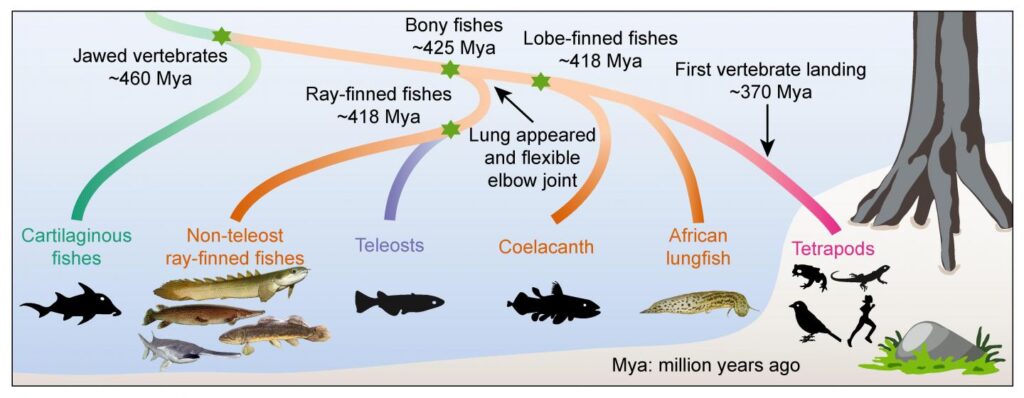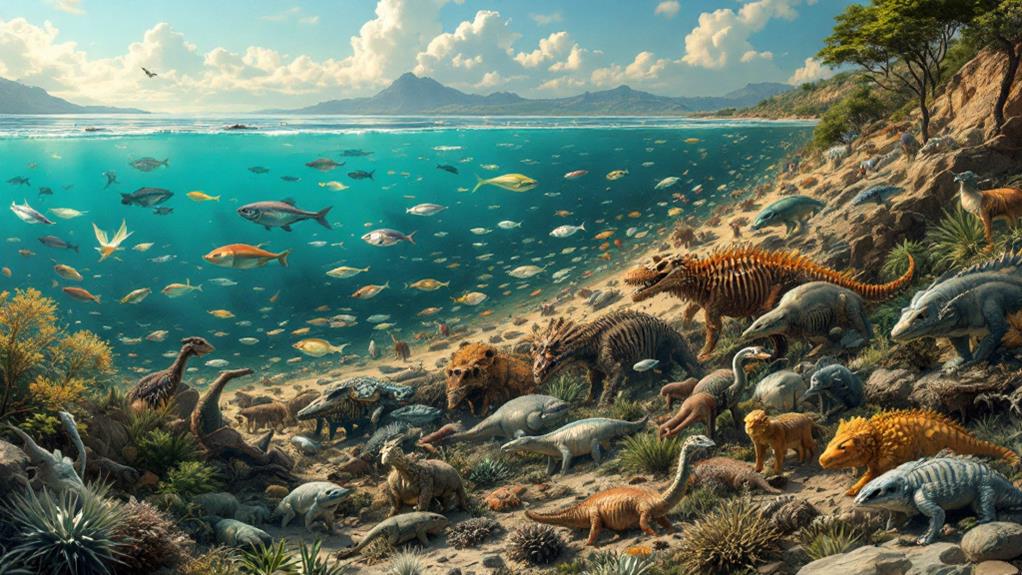You’ll begin an epic 500-million-year journey through vertebrate evolution, witnessing the incredible transformation from simple, jawless fish to the diverse array of complex animals that dominate our planet today. You’ll see the emergence of jaws, the rise of bony fish, and the conquest of land by amphibians. You’ll observe reptiles taking center stage, followed by the reign of dinosaurs. You’ll then watch mammals and birds evolve, diversify, and adapt to fill countless ecological niches. This fascinating timeline reveals the remarkable story of how vertebrates have changed and thrived over eons. There’s so much more to discover about this incredible journey.

Early Vertebrate Origins

Three key periods mark the early origins of vertebrates. The Cambrian period, spanning from 541 to 485 million years ago, saw the emergence of the first vertebrate-like creatures. You’ll find evidence of these early chordates in the fossil record, with organisms like Pikaia and Haikouichthys showing primitive vertebrate characteristics.
The Ordovician period, lasting from 485 to 444 million years ago, witnessed significant developments in vertebrate evolution. During this time, you’d see the appearance of jawless fish, such as conodonts and ostracoderms. These early vertebrates lacked paired fins and jaws but possessed a notochord and a primitive skull.
The Silurian period, from 444 to 419 million years ago, brought about major advancements in vertebrate anatomy. You’d observe the evolution of jawed fish, including placoderms and acanthodians. This period also saw the development of more complex sensory systems and improved locomotion.
Throughout these periods, you’d notice key evolutionary milestones. The development of a cartilaginous skeleton provided support and protection for internal organs. The emergence of a closed circulatory system improved oxygen delivery to tissues. You’d also see the evolution of a more complex brain and sensory organs, enhancing the ability to process environmental information.
These early vertebrates laid the foundation for the diverse array of vertebrate species you see today. Their adaptations to aquatic environments set the stage for future changes to land and air, shaping the course of vertebrate evolution for millions of years to come.
Development of Jaws
The development of jaws marked a pivotal moment in vertebrate evolution, occurring around 430 million years ago during the Silurian period. This adaptation revolutionized feeding strategies and predator-prey relationships in aquatic environments. You’ll find that jawed vertebrates, known as gnathostomes, quickly diversified and became dominant in marine ecosystems.
The emergence of jaws is believed to have evolved from the modification of gill arches. These structures, originally used for breathing and filter feeding, gradually transformed into powerful biting and chewing apparatuses. You can see this shift in the fossil record, with early jawless fish giving way to more advanced, jawed species.
As jaws developed, so did other associated features. You’ll notice the appearance of teeth, which enhanced the efficiency of food capture and processing. Additionally, paired fins evolved, improving maneuverability and predatory capabilities. These changes allowed early jawed vertebrates to exploit new food sources and habitats.
The advent of jaws also led to significant changes in skull structure. You’ll observe the development of a more robust cranium to support jaw muscles and protect the brain. This, in turn, facilitated the evolution of larger brains and more complex sensory systems.
The impact of jawed vertebrates on marine ecosystems was profound. You can trace their influence through the fossil record, as they became top predators and drove the evolution of defensive adaptations in their prey. This evolutionary arms race further accelerated the diversification of both jawed and jawless vertebrates, shaping the course of aquatic life for millions of years to come.
Rise of Bony Fish

Following the development of jaws, bony fish emerged as dominant aquatic vertebrates around 420 million years ago. These fish, known as osteichthyans, evolved from earlier jawed fish and quickly diversified into two main groups: ray-finned fish and lobe-finned fish.
Ray-finned fish, characterized by their fin structure supported by bony spines, became the most diverse and numerous group of fish. They’ve adapted to various aquatic environments, from deep oceans to freshwater lakes. You’ll find familiar examples like salmon, tuna, and goldfish in this group.
Lobe-finned fish, on the other hand, developed fleshy, muscular fins. While less diverse today, they played a significant role in vertebrate evolution. The coelacanth and lungfish are living representatives of this group, but their ancient relatives gave rise to tetrapods—the first vertebrates to venture onto land.
Bony fish introduced several key innovations that contributed to their success. They developed a swim bladder, allowing for better buoyancy control and energy efficiency. Their skeleton, made of bone rather than cartilage, provided stronger support and protection. Additionally, bony fish evolved a more efficient respiratory system with gills protected by bony opercula.
These adaptations enabled bony fish to dominate aquatic ecosystems and diversify into countless species. They’ve colonized nearly every aquatic habitat on Earth, from the deepest ocean trenches to high mountain streams. Today, you’ll find over 30,000 species of bony fish, making them the most diverse group of vertebrates. Their evolutionary success has shaped marine and freshwater ecosystems for hundreds of millions of years.
Emergence of Amphibians
Pioneers of terrestrial life, amphibians emerged around 370 million years ago during the Devonian period. These remarkable creatures evolved from lobe-finned fish, developing essential adaptations that allowed them to venture onto land while maintaining ties to aquatic environments.
You’ll find that early amphibians, like Acanthostega and Ichthyostega, possessed both gills and lungs, enabling them to breathe in water and air. They developed sturdy limbs with digits, replacing the fin-like appendages of their fish ancestors. These limbs provided the support needed to move on land, though early amphibians still spent most of their time in water.
As amphibians evolved, they acquired specialized skin that could absorb oxygen, supplementing their respiratory system. They also developed a three-chambered heart, improving their circulatory efficiency. However, they couldn’t completely break free from water, as their eggs lacked protective shells and required moist environments to develop.
You’ll notice that amphibians diversified rapidly, giving rise to various groups like temnospondyls and lepospondyls. Some grew to massive sizes, like the car-sized Mastodonsaurus, while others remained small and agile.
The emergence of amphibians marked a pivotal moment in vertebrate evolution. They paved the way for fully terrestrial vertebrates, leading to the evolution of reptiles, mammals, and birds. Today, you can observe their descendants – frogs, salamanders, and caecilians – still showcasing the remarkable adaptations that first allowed vertebrates to conquer land while maintaining their aquatic heritage.
Reptiles Take the Stage

Reptiles burst onto the scene around 320 million years ago, during the late Carboniferous period. These pioneering vertebrates evolved from amphibian ancestors and developed key adaptations that allowed them to thrive on land. You’ll find that reptiles were the first fully terrestrial vertebrates, capable of living their entire lives away from water.
One of the most significant innovations in reptile evolution was the amniotic egg. This specialized egg contained a fluid-filled sac that protected the developing embryo, allowing reptiles to lay their eggs on land. You’ll notice that this adaptation freed them from the need to return to water for reproduction, unlike their amphibian predecessors.
Reptiles also developed scales, which helped them retain moisture and protect their bodies from the harsh terrestrial environment. Their lungs became more efficient, enabling them to extract oxygen from air more effectively. You’ll see that these adaptations allowed reptiles to diversify and occupy a wide range of ecological niches.
During the Permian period, reptiles rapidly diversified into various groups. You’ll encounter early ancestors of turtles, lizards, and the impressive synapsids, which would eventually give rise to mammals. The Mesozoic era saw the dominance of reptiles, with dinosaurs, pterosaurs, and marine reptiles ruling the land, air, and sea.
Today, you can observe the legacy of this evolutionary success in modern reptiles like snakes, lizards, crocodiles, and turtles. These animals continue to play essential roles in ecosystems worldwide, demonstrating the enduring impact of reptilian adaptations on vertebrate evolution.
Dawn of the Dinosaurs
As the Triassic period dawned about 252 million years ago, the stage was set for one of the most iconic groups of animals in Earth’s history: the dinosaurs. While they didn’t dominate immediately, their ancestors emerged and began to diversify. You’ll find that early dinosauromorphs, like Lagerpeton and Lagosuchus, appeared during this time, setting the groundwork for the rise of true dinosaurs.
The first true dinosaurs evolved around 230 million years ago. They were small, bipedal creatures that would have seemed unremarkable compared to their contemporaries. However, these early dinosaurs, such as Eoraptor and Herrerasaurus, possessed key anatomical features that would define the group.
As you explore the Late Triassic, you’ll notice dinosaurs becoming more diverse and widespread. They began to fill various ecological niches, competing with other reptiles like pseudosuchians and rhynchosaurs. By the end of the Triassic, about 201 million years ago, dinosaurs had established themselves as a successful group.
The Triassic-Jurassic extinction event marked a turning point. Many competing reptile groups died out, leaving ecological space for dinosaurs to expand rapidly. As you enter the Jurassic period, you’ll witness an explosion of dinosaur diversity. Sauropods grew to enormous sizes, theropods became apex predators, and ornithischians developed new defensive strategies.
This “Dawn of the Dinosaurs” set the stage for their 165-million-year reign, during which they’d evolve into an astounding array of forms and dominate terrestrial ecosystems worldwide.
Mammals’ Evolutionary Journey

While dinosaurs dominated the land, a less conspicuous group was undergoing its own evolutionary journey. Mammals, descendants of synapsids, emerged during the Triassic period, about 225 million years ago. These early mammals were small, nocturnal creatures, often no larger than modern-day mice.
You’ll find that early mammals diversified into three main groups: monotremes, marsupials, and placentals. Monotremes, like the platypus, retained reptilian features such as egg-laying. Marsupials and placentals developed more advanced reproductive strategies, with marsupials giving birth to underdeveloped young and placentals nurturing their offspring in the womb for longer periods.
Throughout the Jurassic and Cretaceous periods, mammals continued to evolve, developing key adaptations. They acquired warm-blooded metabolism, allowing for increased activity and energy efficiency. Their jaws and teeth became more specialized, enabling a wider range of diets. Mammals also evolved complex social behaviors and improved parental care.
Despite these advancements, mammals remained relatively small and inconspicuous during the age of dinosaurs. It wasn’t until the mass extinction event 66 million years ago that mammals truly flourished. With the disappearance of large dinosaurs, mammals rapidly diversified and occupied newly available ecological niches.
In the following millions of years, you’d witness an explosion of mammalian diversity. From tiny shrews to massive whales, from gliding squirrels to subterranean moles, mammals adapted to a wide range of habitats and lifestyles. This remarkable evolutionary journey ultimately led to the diverse array of mammals you see today, including humans.
Birds: Masters of Flight
The story of vertebrate evolution takes flight with the emergence of birds. These feathered descendants of theropod dinosaurs have become masters of the air, adapting to diverse environments across the globe.
Birds first appeared during the Jurassic period, about 150-160 million years ago. The famous Archaeopteryx, discovered in Germany, represents one of the earliest known bird-like creatures. It had both reptilian and avian features, including teeth, a long bony tail, and feathered wings.
As birds evolved, they developed key adaptations for flight. Their bones became hollow and lightweight, while their respiratory system became more efficient with air sacs. Birds’ forelimbs transformed into wings, and they developed a unique furcula (wishbone) to support flight muscles.
You’ll find that modern birds, which appeared about 100 million years ago, have diversified into over 10,000 species. They’ve conquered nearly every habitat on Earth, from the freezing Antarctic to scorching deserts.
Birds’ success isn’t just due to flight. They’ve developed remarkable features like specialized beaks for different diets, advanced color vision, and complex vocalizations for communication. Some species have even lost the ability to fly, adapting to terrestrial or aquatic lifestyles.
Today, birds continue to evolve and adapt to changing environments. They face new challenges from human activities and climate change, but their remarkable ability to adapt has allowed them to thrive for millions of years. As you observe birds in your daily life, remember that you’re witnessing the latest chapter in a long evolutionary story that began with their dinosaur ancestors.

Erzsebet Frey (Eli Frey) is an ecologist and online entrepreneur with a Master of Science in Ecology from the University of Belgrade. Originally from Serbia, she has lived in Sri Lanka since 2017. Eli has worked internationally in countries like Oman, Brazil, Germany, and Sri Lanka. In 2018, she expanded into SEO and blogging, completing courses from UC Davis and Edinburgh. Eli has founded multiple websites focused on biology, ecology, environmental science, sustainable and simple living, and outdoor activities. She enjoys creating nature and simple living videos on YouTube and participates in speleology, diving, and hiking.

